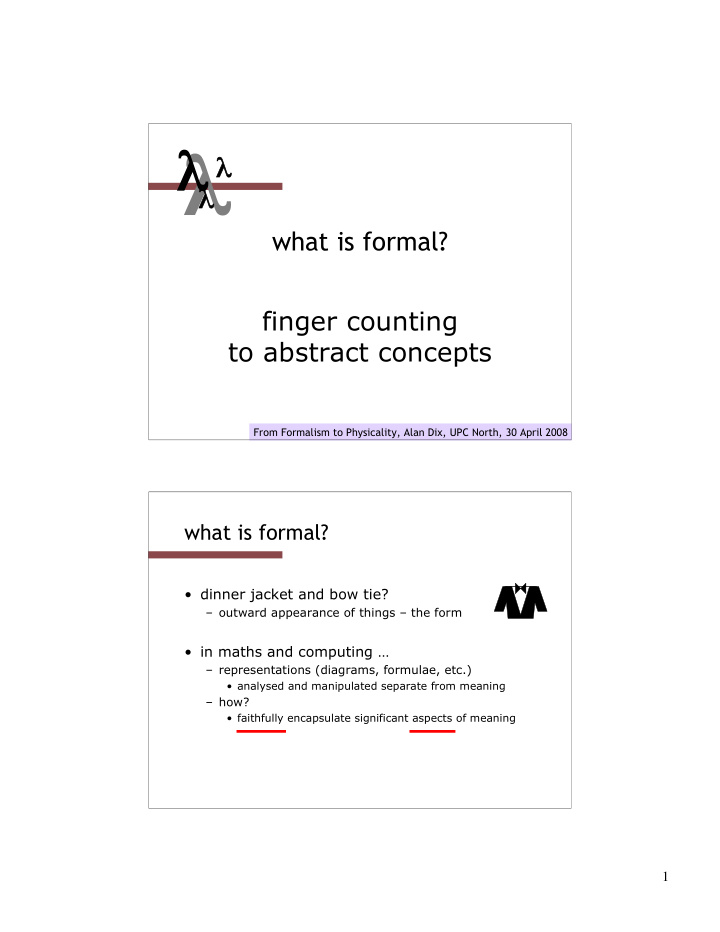



� � � � what is formal? finger counting to abstract concepts From Formalism to Physicality, Alan Dix, UPC North, 30 April 2008 what is formal? • dinner jacket and bow tie? – outward appearance of things – the form • in maths and computing … – representations (diagrams, formulae, etc.) • analysed and manipulated separate from meaning – how? • faithfully encapsulate significant aspects of meaning 1
counting cockroaches - first night 213 counting cockroaches - second night 279 2
which night had more? • second night: 279 > 213 • how can you be certain? – count faithfully represents significant feature • but not everything … – cockroaches on first night may be: – bigger, different colour, more friendly representing things absent • symbols, icons, words – stand for things not present • simulated screen shots – represent the unrealised designs (N.B. no dynamics – limited meaning) • counting cockroaches – keep in a jam jar? disrupts the world – numbers make the impossible possible 3
placeholders • homunculus – any person – not just someone, anyone • maths: � n: n+1 > n – saying an infinite amount • counting: 279 > 213 – cockroaches, apples, llamas abstraction • increasing abstraction – screenshot – one screen – storyboard – single sequence of interaction – navigation diagram – potential paths • and further ... – work on UNDO – any system with particular properties ... 4
forcing you to think when you count cockroaches you have to decide baby or adult what counts as a cockroach • baby or adult live or dead • live or dead the myth of informality • spiritus mundi – formality, precision = reductionism, positivism = BAD • focus (rightly) on – context, situatedness, contingency • BOTH needed – the world is rich and complex – but computers are formal (as is language) – key is choosing the right abstractions – and knowing what is left out 5
� � � � early examples formalism in action digital watch – user instructions Time display Stop watch S M T W T F S S M T W T F S • two main modes A STP • limited interface - 3 buttons Depress button A A A for 2 seconds • button A changes mode S M T W T F S S M T W T F S A SET ALM • state transition AM network (STN) Time setting Alarm setting 6
example - nuclear control Alarm Control • what happens if we press ‘+’ in red mode? + N.B. question from form only – + + GREEN AMBER RED – – digital watch – user instructions Time display Stop watch “depress button A S M T W T F S S M T W T F S for 2 seconds” A STP so ... Depress button A • time important A A for 2 seconds S M T W T F S S M T W T F S • distinguish depress A A SET ALM and release A AM Time setting Alarm setting 7
designer’s instructions Time display Stop watch S M T W T F S S M T W T F S STP and ... Depress A Release A Release A that’s just S M T W T F S S M T W T F S one button STP 2 seconds 2 seconds Depress A Release A S M T W T F S S M T W T F S Release A Depress A SET ALM AM Time setting Alarm setting lessons • formal analysis – ask questions based on form of diagrams • early analysis – catch problems even before prototyping • lack of bias – usually test what we expect, analysis breaks this • alternative perspective – different representations show different things • forcing design decisions – did watch designer make these decsions or programmer? 8
Recommend
More recommend